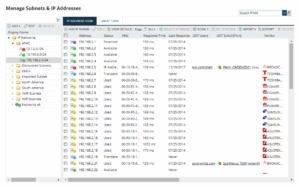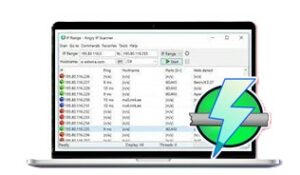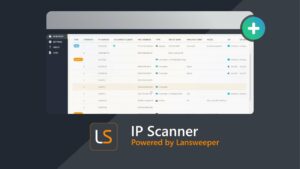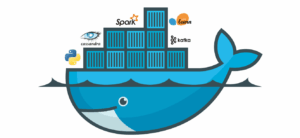As a network administrator, you require IP Scanner tools in order to administer your network. You may take control of your network and the devices connected to it using these programs.
We’ll go over the top IP scanner programs in this post so you can control devices using their IP addresses. We’ll also include a list of multifunctional network scanning software, such as vulnerability and IP address scanning in addition to network scanning.
Now let’s get going.
What is the purpose of network scanning tools and IP scanners?
IP scanners find IP addresses by first analyzing the network. It also provides more pertinent data related to the devices connected to those IP addresses. To locate IP ranges, these IP scanners use ICMP ping sweeps. Additionally, it generates SNMP scans to map the topology of networks. To put it briefly, an IP scanner allows you to record device IP, DNS, and Dynamic Host Configuration Protocol (DHCP) data.
Conversely, network scanners include details such MAC address, vendor type, and hostname. Network scanners are another tool that network managers can employ to swiftly troubleshoot the network.
Advantages of using IP scanner software
IP management is provided by IP scanner software along with accurate IP address usage data. Additionally, they simplify the work of network administrators by automating IP scanning. In this manner, you can avoid dealing with data that is prone to errors by eliminating the need for manual IP scanning.
The following are some of the main advantages:
-
-
- Rapid access to network information.
- Simple IP address and subnet discovery.
- IP addresses on networks are automatically updated.
- IP subnet management and scanning.
- Obtain essential data for network mapping and organization.
- IP scanning support for both IPv4 and IPv6 addresses simplifies monitoring.
- Maintain consistency in IP allocation by using appropriate IPv4 and IPv6 scanning.
- Establish a centralized console for network device management.
- Find out everything there is to know about the use of IP resources, including system name, MAC address, network type, asset details, last scan time, and even physical address.
- Enhance network performance by using subnets to properly partition and use available space.
- By IP scanning several subnets and supernets in real-time, IP scanner software simplifies the management of dynamic networks.
- Keeps ahead of IP resource exhaustion and permits appropriate capacity planning.
- Proactively monitoring with the IP scanner can help you avoid expensive network problems.
-
To learn more about the advantages of an IP Scanner, visit 5 key benefits of using an IP scanner – ManageEngine.
Top 11 IP Scanner Tools For Network Management
Network administrators can effectively manage the entire network by using IP Scanner tools, which are excellent at scanning IP ranges. These tools eliminate the need to install local software on each network device by operating on the Agentless Asset Discovery principle. Several SNMP and ICMP techniques are used by IP Scanner software to deliver real-time insights. Additionally, because these IP address scanner tools support multi-thread scan technology, they operate quickly. Finally, simple port scanning, including port switching, is another feature of IP scanner tools.
Now let’s get going.
1. SolarWinds IP Address Manager
SolarWinds IP Address Manager allows network administrators to handle, track, and maintain IP addresses. You can use it to learn about IP address space, how it is used, and a lot more. In addition, you have control over DNS and DHCP.
Among its primary attributes are:
-
-
- Save time by eliminating the need for manual checks with automatic IP scanning.
- Using a single, centralized panel, administrators can manage IP, DNS, and DHCP.
- Outstandingly easy interface.
- Supports reporting, troubleshooting, and alerting of IP addresses.
- Historical data, available IP addresses, and current usage are all included in comprehensive IP address utilization tracking.
- Offers integration with third-party software
-
There is a 30-day free version available, but it is not free to use.
2. OpUtils
OpUtils by ManageEngine enables network administrators to control IP addresses and switch ports. Since they can quickly identify, track, and resolve network issues, network engineers have complete control. By using appropriate IPv4 and IPv6 subnet scanning, administrators can ascertain the number of IP addresses that are available.
It also has additional features like:
-
-
- Rogue device detection to locate and disable devices that have not been verified.
- Track the amount of bandwidth used by the network with a bandwidth monitor.
- Create graphs using SNMP tools for improved visualization.
- Network inactive machines can be manually or automatically rebooted.
- Keep an eye on vital servers and receive notifications for problems that require quick attention.
- Supports a specific IP range for IP scanning.
- Get essential information like system specs, IP address, etc. by scanning TCP ports and SNMP-capable devices.
-
3. PRTG Network Monitor
PRTG Network Monitor by Paessler is a monitoring tool suitable for enterprise use that functions in a variety of settings. Administrators can keep an eye on every system, including linked devices, connections, apps, and more. Additionally, it provides a central management console with an eagle-eye view that saves you time. It is fully customizable and supports on-premise installation as well.
It has numerous features, such as:
-
-
- Operates on Linux, macOS, and Windows.
- Supports numerous protocols for managing and scanning IP addresses.
- Provides alerts and real-time monitoring in case there are network problems.
- Determine available addresses for simple assignments.
- Analysis of traffic and bandwidth.
- Customizable dashboards.
- A mobile app for monitoring and controlling remotely.
-
4. Angry IP Scanner
Check out Angry IP Scanner if you’re searching for a quick and user-friendly IP scanner. The scanner is compatible with Mac, Linux, and Windows and is cross-platform. It can search IP addresses in any range and on any port. You can ping each and every machine in the network to check if it is still alive after you launch Angry IP Scanner. It also aids in the resolution of IP disputes. You can obtain more data with Angry IP Scanner, such as hostname, scan ports, etc. Plugins enable you to gather additional data. Additionally, it makes it simple to export data to TXT, CSV, XML, or IP Port list files.
Features of Angry IP Scanner include:
-
-
- Supports multithreaded approach to speed up scanning.
- Easily export scanning results in TXT, CSV, XML, or IP-Port list files.
- Assemble NetBIOS information.
- Provide options for configuring scanning and web server detection.
- Locate duplicate IP addresses across the entire network.
- Excellent in hybrid environments.
-
It is open-source and free to use.
5. IP Range Scanner
The IP Range Scanner from Lansweeper is available for free usage. Users can use it to scan computers, routers, and other network devices. An intuitive and configurable interface is provided by the IP scanner. By obtaining essential details like IP address, hostname, operating system, and hardware information with it, you can save time.
There are many features included with the IP Range Scanner, including:
-
-
- Schedule IP range network scan.
- Quick and precise scanning.
- Ability to extract modifiable scanned data.
- Quickly import network setup using CSV file.
- Dismiss devices according to IP address or Type.
- It functions great on the Local area network (LAN).
- Scan results include comprehensive device information, including open ports, network services, etc.
-
You can use the free version on up to 100 devices. You have to purchase their enterprise version if you have more than that.
6. Free IP Scanner
Free IP Scanner is a free-to-use software that provides an easy-to-use method for searching for information on your network. You can use it to find out the IP status of network devices that are connected.
The following features are yours to have here:
-
-
- Fully adjustable port scanner.
- It makes use of multi-threaded IP scanning for quick output.
- Save the outputs in text files.
- Displays NetBIOS information, including logged users.
-
7. Advanced IP Scanner
Advanced IP Scanner is another free network scanner that lets you examine LANs. It comes with remote PC control via RDP and Radmin in addition to IP scanning.
Here are the features that you can access if you choose to use Advanced IP Scanner:
-
-
- Network IP scanning.
- Remote control of computers.
- It is provided in a portable format.
- Export scans to CSV.
- Simple to turn.
-
8. Intruder
Intruder is a complete network scanning solution that offers comprehensive IP scanning and more. This cyber-security tool enables you to identify weaknesses in your product. You can monitor threats across all of your devices with it. It can detect problems like bugs, misconfiguration, cross-site scripting, and more. It helps IT organizations to remain safe from over 10,000 vulnerabilities.
Some of its notable features include:
-
-
- Full vulnerability scanning.
- Utilizes cloud-based systems.
- Penetration tests.
- Personalized monitoring.
- Monitor ongoing attacks.
- Intelligent, actionable results with appropriate context.
- Supports a wide range of integrations such as AWS, Slack, etc.
-
Intruder software is a paid solution targeting businesses.
9. Fing
Fing is a free-to-use IP scanner that lets you list all your network devices. It offers essential details about scanned devices, including the IP address, device name, manufacturer, vendor, and so forth, just like other IP address scanners. It also provides sophisticated NetBIOS information.
With Fing, you get the following features:
-
-
- Provides a mobile app.
- Find network intruders.
- Run internet speed tests.
- Supports LAN and Wi-Fi networks.
- Offers network alteration.
- Provides troubleshooting tools such as port scanning.
-
10. SolarWinds Port Scanner
To optimize your network management, you would probably need a port scanner. SolarWinds port scanner lets you identify port behavior. This way, you can find network vulnerabilities and fix them.
Here with Solarwinds Port Scanner, you get the following features:
-
-
- Do customize scans based on IP addresses.
- Do multiple threads of scanning for faster execution.
- Understand network configuration and setup.
- Obtain proper port status across the network.
- Examine and test open and closed ports for vulnerabilities and flaws.
-
11. Using Nmap
Nmap is a useful command-line tool that works with Windows, Linux, and macOS, among other major operating systems. For Network Mapper, it stands. It is free to use because it is an open-source tool. Finding port rules, network mapping, operating system detection, service discovery, vulnerability scanning, and shadow IT hunting are some of its primary functions. Nmap is classified as an advanced IP scanner because it can find vulnerabilities.
The following features of Nmap:
-
-
- Discover and find live hosts on a network.
- Scan for open ports.
- Discover and learn about services.
- Test for weaknesses and vulnerabilities.
-
The Nmap command in Linux is as below.
nmap [hostname/IPaddress]
If you want to read more about Nmap, check out Nmap documentation.
Conclusion
In summary, strong IP Scanner tools are essential for efficient network administration. The best IP scanner software was discussed in this guide, along with its many features for effective IP address-based device management. These tools provide a wide range of functions that are essential for strong network security and configuration, whether for IP range scanning, remote PC control, or vulnerability detection.








